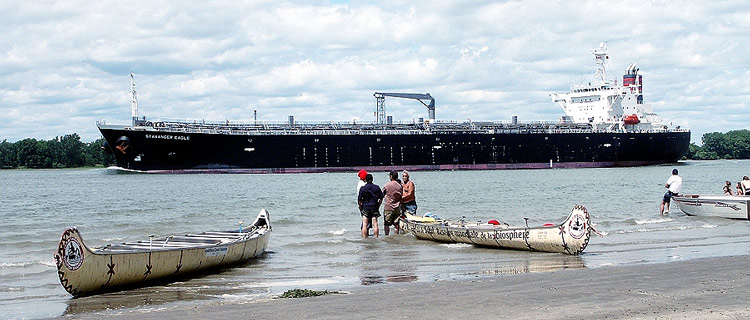
Watershed governance
We need to talk
Improved collaboration between different management groups can boost the governance of shared watersheds
Never underestimate the power of social networks. Research has previously shown how better dialogue can help the interaction between different actor groups in the management of urban ecosystems.
Watershed governance may not be any different.
A point of conflict
In a study recently published in Ecology and Society, centre researcher Garry Peterson and Kaitlyn Rathwell of University of Waterloo has looked at how social networks affect the coordination among different stakeholders in Montérégie, an agricultural landscape near Montréal, Quebec. The landscape is known for its diverse landscape which offers a range of ecosystem services derived from orchards, winding rivers, mountains, and industrial agriculture. However this diversity has led to tradeoffs between tourism and agriculture.
"In many densely settled watersheds, water quality is a point of conflict between various groups with different practices, values and management structures," says lead author Kaitlyn Rathwell.
The paper adds a lens to how we approach collective stewardship of ecological systems. It does this in three ways. First, it links water governance networks with the actual water and how it flows across the landscape. Second, it shows that bridging organisations do important work in creating networks for governance but that sometimes they end up bridging the same types of people together which can lead to divisions rather than cooperation. Finally, the study suggests that municipalities that have robust social networks also engage in more water quality management activities.
In their study, Rathwell and Peterson introduce innovative methods to capture social-ecological dynamics by combining social network analysis with geographical information systems (GIS) and spatial analysis, to map and assess how 34 municipalities worked with one another directly or indirectly.
Little direct contact
Contrary to their expectations, Rathwell and Peterson found that municipalities did not collaborate directly with one another. Instead, they are connected via bridging organisations. However, these organisations preferentially connected with municipalities focused on tourism-related ecosystem services. Many agricultural municipalities remained relatively isolated, despite being the main source of water quality problems.
"Because poor water quality is a problem in Montérégie, we expected that municipalities would work with one another to address this problem," says co-author Garry Peterson.
While other scholars emphasize the positive role of bridging organisations, Rathwell and Peterson argue that the role of bridging organisations is complex and needs more attention. In their study, while crucial to improved governance of water, bridging organisations also reinforce social-ecological divides by being more connected to tourist areas thus reinforcing social-ecological divisions in the landscape.
"The fact that bridging organisations work the least with municipalities who pollute the water most, contributes to the inability of the region to solve their shared water quality problems," says Garry Peterson.
Disjointed, but with much potential
Rathwell and Peterson present in their study three overlapping strategies to address weaknesses in the water management network. Firstly, government organisations should improve the collaboration between municipal and larger scale government organisations. Secondly, NGOs should collaborate closer with more municipalities. Last, but not least, municipalities should work closer together.
"Bottom line, our paper is about how to set up communication pathways so people that want different things from diverse ecological landscapes can communicate and hopefully compromise with each other," says Kaitlyn Rathwell.
Reference: Rathwell, K. J., and G. D. Peterson. 2012. Connecting social networks with ecosystem services for watershed governance: a social-ecological network perspective highlights the critical role of bridging organizations. Ecology and Society 17(2): 24. http://dx.doi.org/10.5751/ES-04810-170224
References
Rathwell, K. J., and G. D. Peterson. 2012. Connecting social networks with ecosystem services for watershed governance: a social-ecological network perspective highlights the critical role of bridging organizations. Ecology and Society 17(2): 24. http://dx.doi.org/10.5751/ES-04810-170224
Garry Peterson is Professor in Environmental Sciences with key focus on resilience in social-ecological systems. His research addresses strategies to improve people's ability to ensure a reliable supply of the ecosystem services that support human well-being.
Kaitlyn J. Rathwell is a PhD candidate at the Environmental Change & Governance Group at University of Waterloo. Her research interests include social-ecological systems, governance, knowledge systems art and network analysis. Read her blog here






